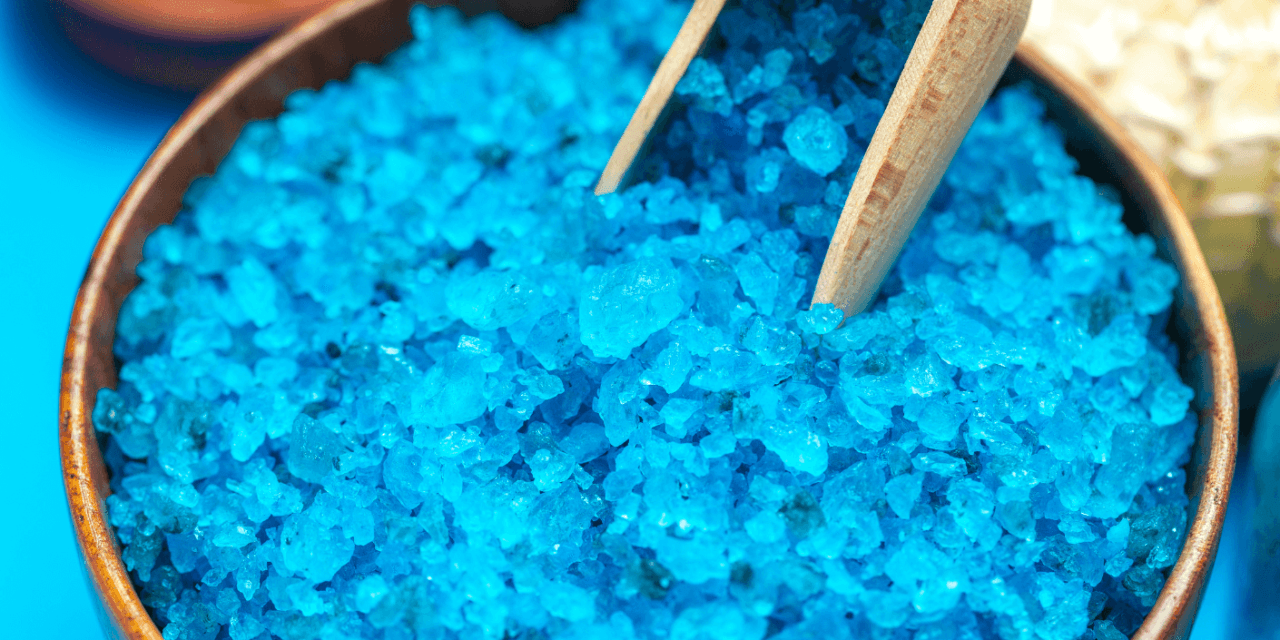In the world of gourmet salts, Persian Blue Salt stands out not only for its striking hue but also for its purported health benefits. Originating from the ancient salt mines of Iran (formerly Persia), this rare salt has been gaining popularity among food enthusiasts and health-conscious individuals alike. But this growing interest leads to a crucial question: Is Persian Blue Salt healthy?
While its striking appearance may elevate the presentation of gourmet dishes, does it offer any advantages over regular table salt? To assess its true value, we must look beyond aesthetics and explore whether Persian Blue Salt delivers on its reputation for health benefits.
It’s important to remember that not all salts are the same. Persian Blue Salt distinguishes itself with its vivid color and rich history, often used by chefs for culinary flair or valued in traditional remedies. Yet, the ultimate question remains: Does it deserve a place in our daily wellness routine?
What Is Persian Blue Salt?
Persian blue salt, formed in ancient ponds millions of years ago, is harvested from Iran and was first discovered by Persian soldiers around 2,000 years ago. The salt is carefully hand-mined using sustainable methods, ensuring that its natural composition and rich mineral content are preserved.
In addition to its striking appearance, Persian blue salt offers potential health benefits due to its high mineral content. It is thought to help balance electrolytes, improve hydration, and promote overall well-being.
Furthermore, one of the most fascinating aspects of Persian blue salt—and a key reason for its growing popularity online—is its reputation as a luxury ingredient in gourmet cooking and fine dining. Chefs around the world appreciates its delicate texture and subtle flavor, which enhances dishes without overpowering them.
What Makes Persian Blue Salt, Blue?
The striking blue hue of Persian Blue Salt is due to its high mineral content, particularly the presence of sylvinite, a potassium-rich mineral. This unique composition is what gives the salt its distinct color, clearly setting it apart from other salts.
Moreover, the formation of Persian Blue Salt occurs over hundreds of years, as seawater evaporates in salt marshes. During this process, minerals like sylvinite become concentrated and crystallized, resulting in the stunning blue crystals we see today.
Unlike artificial food colorings that are often added for visual enhancement, the blue color of Persian Blue Salt is completely natural, a result of geological processes. This natural coloring not only adds to its aesthetic appeal but also indicates the richness of minerals present in the salt.
Nutritional Content Of Persian Blue Salt
Persian blue salt, being rich in essential minerals, contains:
- Magnesium: Vital for over 300 biochemical reactions in the body, including energy creation and muscle movement.
- Potassium: Contributes to cardiovascular health and reduces the risk of mortality by supporting muscle and bone strength.
- Sodium: Vital for regulating body fluids and supporting proper nerve and muscle function.
- Calcium: The most plentiful mineral in the body, essential for maintaining bone strength and enabling muscle function.
| Nutrient | Amount per 10g | % Daily Value (DV) |
| Magnesium | 0.59 mg | 0.14% |
| Potassium | 0.36 mg | 0.01% |
| Sodium | 3,968 mg | 172.96% |
| Calcium | 1.20 mg | 0.12% |
| Iron | 0.01 mg | 0.06% |
| Zinc | Trace | <0.01% |
6 Health Benefits Of Persian Blue Salt
These benefits underscore the potential health-promoting properties of Persian blue salt, especially when used in moderation as part of a balanced diet. To explore this further, let’s examine the following key points:
1. The Enriching Minerals
Persian blue salt is treasured not only for its striking color but also for its mineral content. As discussed before, it contains essential minerals like magnesium, calcium, potassium, and iron, which are vital for maintaining good health.
2. Antioxidant Properties
Some health professionals suggest that the antioxidant properties of Persian salt could help reduce oxidative stress in the body, minimizing cellular damage. This potentially contributes to overall health benefits, although specific scientific evidence supporting these claims is limited.
3. Low Sodium Content
Compared to regular table salt, it has a lower sodium content, which can be beneficial for individuals trying to lower their daily sodium intake.
4. Regulates Blood Pressure
Persian Blue Salt is known to help regulate blood pressure due to its mineral content, particularly potassium, which plays a role in cardiovascular health.
5. Supports Hydration
The minerals found in Persian Blue Salt, including magnesium and potassium, help regulate fluid balance in the body and support effective hydration.
6. Alkalizing Effects
Some studies suggest that Persian Blue Salt may have alkalizing effects on the body, which can help balance the body’s pH levels.
Potential Drawbacks
However, consuming too much salt, including Persian blue salt, can lead to health issues like high blood pressure and cardiovascular disease. Therefore, it is essential to use it in moderation and as part of a balanced diet.
Given the lack of extensive research on the specific health benefits of the Persian salt, it’s advisable to consult a doctor before incorporating it into your diet, especially if you have health concerns related to salt intake
Culinary Uses and Aesthetic Appeal
Let’s continue to read by going into the specific culinary uses and the visual allure that make Persian Blue Salt a standout ingredient.
1. Elevating Seafood Dishes
Persian Blue Salt’s rich mineral composition makes it an excellent match for seafood. It enhances the natural flavors of fish and shellfish without overwhelming them. A light sprinkle on grilled salmon or scallops can turn a simple dish into a gourmet experience.
2. Finishing Touch for High-End Cuisine
Due to its striking blue color and delicate flavor, Persian Blue Salt is a favorite finishing salt in luxury dining establishments. It adds both a visual and taste sophistication to dishes, making it a must-have for chefs aiming to impress.
3. Enhancement of Sweet Treats
The unique flavor profile of Persian Blue Salt pairs exquisitely with caramel and chocolate, providing a delightful contrast that surprises the palate. Thus, it is perfect for sprinkling over desserts such as chocolate lava cake or salted caramel brownies.
4. Versatile Ingredient for Creative Cooking
Persian Blue Salt is versatile in its use, complementing everything from BBQ’d vegetables and meats to stews, soups, and roasts. Its ability to enhance a wide range of dishes makes it a valuable addition to any kitchen.
5. Artistic Presentation
The deep blue hue of Persian Blue Salt provides an artistic element to dish presentation. Whether used as a garnish or incorporated into the meal itself, it’s bound to grab attention and spark conversation at the table.
Is Persian Blue Salt Good For You?
Like all salts, Persian blue salt is mainly composed of sodium chloride, and excessive sodium intake can lead to health issues such as hypertension and cardiovascular disease. While Persian blue salt does offer more minerals compared to regular table salt, it is still important to use it sparingly to maintain a balanced diet.
Therefore, Persian blue salt can be a beneficial addition to your diet when used in moderation. Its unique mineral content provides various health benefits; however, it’s crucial to adhere to the recommended daily sodium intake to ensure it supports your health positively.
Is Persian Blue Salt Healthier Compared To Other Popular Types Of Salts?
Determining whether Persian Blue Salt is healthier compared to other popular types of salts depends on various factors including its mineral content, processing methods, and how it fits into an individual’s overall diet and health needs.
Each salt brings its own set of benefits and flavors to the table, and the choice often depends on personal preference and specific dietary needs.
| Salt Type | Sodium | Potassium | Magnesium | Calcium | Iron | Flavor Profile |
| Persian Blue Salt | Lower | High | High | Moderate | Low | Mild, slightly sweet |
| Himalayan Pink Salt | Moderate | Moderate | Moderate | High | High | Subtle, earthy |
| Table Salt | High | Low | Low | Low | Low | Neutral |
| Fleur de Sel | Low | Moderate | Moderate | Moderate | Low | Delicate, slightly briny |
| Celtic Sea Salt | Low | High | High | High | Moderate | Salty, mineral-rich |
| Kosher Salt | Moderate | Low | Low | Low | Low | Mild, coarse |
Authenticity
When considering the authenticity and safety of Persian blue salt, several factors must be evaluated to ensure you receive a genuine and safe product.
The authenticity of Persian salt can be determined by its unique blue hue and mineral composition. However, as with any rare product, there is a risk of counterfeit salts on the market. To ensure authenticity, it’s recommended to purchase it from reputable sources that provide traceability back to the original mining locations.
Safety Concerns
Persian Blue Salt is celebrated for its exceptional purity, being free from environmental pollutants and modern-day contaminants. This high quality guarantees a pure and untouched enhancement to your culinary creations. However, as with all salts, it should be consumed in moderation.
To mitigate any safety concerns, you should:
- Verify the source of the Persian Blue Salt to ensure it is reputable.
- Look for certifications or quality assurances that confirm the salt’s purity and safety.
- Use the salt sparingly as part of a balanced diet to avoid excessive sodium intake.
Final Thoughts
Persian blue salt is a remarkable natural wonder that not only adds a splash of color and flavor to our dishes but also offers a range of potential health benefits. Its unique mineral content, including lower sodium levels and essential nutrients like potassium, calcium, and magnesium, can positively impact our health when used in moderation.
However, it’s crucial to remember that the key to enjoying these benefits lies in balanced consumption. Like all salts, excessive intake can lead to health complications.
Therefore, is Persian blue salt healthy? The answer depends on its mindful use as part of a varied and balanced diet, allowing you to appreciate its qualities while respecting its potency.








